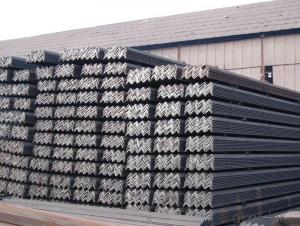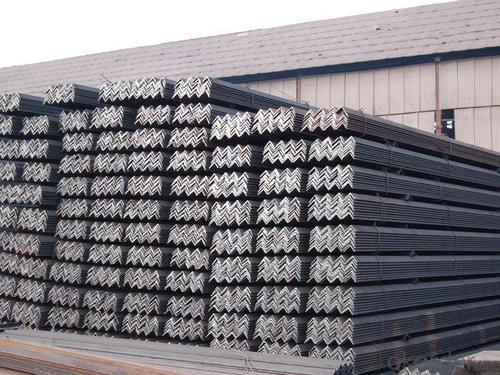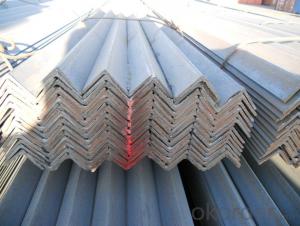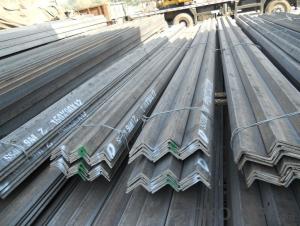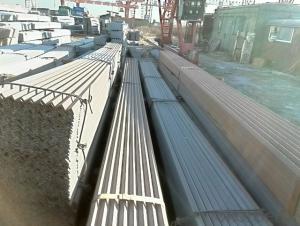Hot Rolled Carbon Angle Steel Iron
- Loading Port:
- China Main Port
- Payment Terms:
- TT or LC
- Min Order Qty:
- 100 m.t.
- Supply Capability:
- 10000MT m.t./month
OKorder Service Pledge
OKorder Financial Service
You Might Also Like
Product Description:
OKorder is offering Hot Rolled Carbon Angle Steel Iron at great prices with worldwide shipping. Our supplier is a world-class manufacturer of steel, with our products utilized the world over. OKorder annually supplies products to African, South American and Asian markets. We provide quotations within 24 hours of receiving an inquiry and guarantee competitive prices.
Product Applications:
Hot Rolled Carbon Angle Steel Iron are ideal for structural applications and are widely used in the construction of buildings and bridges, and the manufacturing, petrochemical, and transportation industries.
Product Advantages:
OKorder's Hot Rolled Carbon Angle Steel Iron are durable, strong, and wide variety of sizes.
Main Product Features:
· Premium quality
· Prompt delivery & seaworthy packing (30 days after receiving deposit)
· Can be recycled and reused
· Mill test certification
· Professional Service
· Competitive pricing
Product Specifications:
Manufacture: Hot rolled
Grade: Q195 – 235
Certificates: ISO, SGS, BV, CIQ
Length: 6M-12m, as per customer request
Packaging: Export packing, nude packing, bundled
EQUAL ANGLES SIZES |
| ||
a(mm) | a1(mm) | thickness(mm) | length |
25 | 25 | 2.5---3.0 | 6M/12M |
30 | 30 | 2.5---4.0 | 6M/12M |
38 | 38 | 2.5 | 6M/12M |
38 | 38 | 3.0---5.0 | 6M/12M |
40 | 40 | 3.0---6.0 | 6M/12M |
50 | 50 | 3 | 6M/12M |
50 | 50 | 3.7---6.0 | 6M/9M/12M |
60 | 60 | 5.0---6.0 | 6M/9M/12M |
63 | 63 | 6.0---8.0 | 6M/9M/12M |
65 | 65 | 5.0---8.0 | 6M/9M/12M |
70 | 70 | 6.0---7.0 | 6M/9M/12M |
75 | 75 | 5.0---10.0 | 6M/9M/12M |
80 | 80 | 6.0---10.0 | 6M/9M/12M |
90 | 90 | 6.0---10.0 | 6M/9M/12M |
100 | 100 | 6.0---12.0 | 6M/9M/12M |
120 | 120 | 8.0-12.0 | 6M/9M/12M |
125 | 125 | 8.0---12.0 | 6M/9M/12M |
130 | 130 | 9.0-12.0 | 6M/9M/12M |
140 | 140 | 10.0-16.0 | 6M/9M/12M |
150 | 150 | 10---15 | 6M/9M/12M |
160 | 160 | 10---16 | 6M/9M/12M |
180 | 180 | 12---18 | 6M/9M/12M |
200 | 200 | 14---20 | 6M/9M/12M |
FAQ:
Q1: Why buy Materials & Equipment from OKorder.com?
A1: All products offered byOKorder.com are carefully selected from China's most reliable manufacturing enterprises. Through its ISO certifications, OKorder.com adheres to the highest standards and a commitment to supply chain safety and customer satisfaction.
Q2: How do we guarantee the quality of our products?
A2: We have established an advanced quality management system which conducts strict quality tests at every step, from raw materials to the final product. At the same time, we provide extensive follow-up service assurances as required.
Q3: How soon can we receive the product after purchase?
A3: Within three days of placing an order, we will arrange production. The normal sizes with the normal grade can be produced within one month. The specific shipping date is dependent upon international and government factors, the delivery to international main port about 45-60days.
Images:

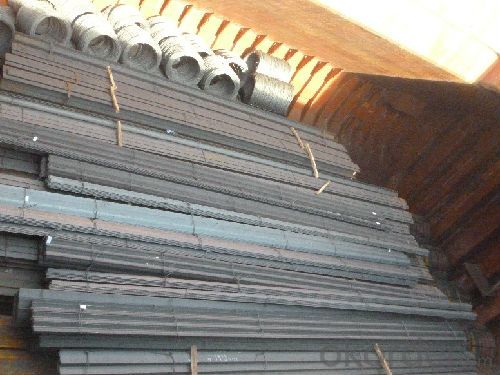

- Q: How do steel angles perform in terms of thermal conductivity?
- Steel angles have relatively low thermal conductivity compared to other materials, meaning that they do not easily conduct heat. This property makes steel angles less prone to thermal expansion or contraction, making them suitable for various applications where temperature fluctuations are a concern.
- Q: What are the different methods of corrosion protection for steel angles?
- There are several methods of corrosion protection for steel angles, each with its own advantages and disadvantages. 1. Coatings: One of the most common methods is applying protective coatings on the steel angles. This can include paint, epoxy, or galvanization. Paint acts as a barrier between the steel and the environment, preventing moisture and oxygen from reaching the metal surface. Epoxy coatings provide a thicker and more durable layer, offering enhanced protection against corrosion. Galvanization involves applying a layer of zinc to the steel surface, which acts as a sacrificial barrier, corroding before the steel does. 2. Cathodic Protection: This method involves the use of an external electrical current to protect the steel angles. By connecting the steel to a more easily corroded metal, such as zinc or magnesium, and applying a direct current, the less noble metal corrodes instead of the steel. This method is particularly useful in marine or underground environments. 3. Alloying: Another way to protect steel angles from corrosion is through alloying. By adding small amounts of other metals, such as chromium or nickel, to the steel composition, the resulting alloy forms a protective oxide layer on the surface, which prevents further corrosion. Stainless steel is a common example of an alloy that offers excellent corrosion resistance. 4. Barrier Films: Applying a barrier film to the steel surface is another method to protect against corrosion. This involves applying a protective film, such as polyethylene or PVC, to create a physical barrier that prevents moisture and oxygen from reaching the steel. This method is commonly used in applications where the steel angles are exposed to harsh environments or chemicals. 5. Environmental Control: Controlling the environment in which the steel angles are placed can also help prevent corrosion. This includes minimizing exposure to moisture, humidity, and corrosive chemicals. Proper ventilation, regular cleaning, and maintaining a dry environment can all contribute to corrosion prevention. It is important to note that the best method of corrosion protection for steel angles depends on various factors, including the specific application, environmental conditions, and budget constraints. It is recommended to consult with corrosion experts or engineers to determine the most suitable method for a particular scenario.
- Q: Can steel angles be used for manufacturing storage racks?
- Yes, steel angles can be used for manufacturing storage racks. Steel angles are versatile and strong, making them an ideal choice for constructing storage racks. They provide stability and structural integrity to the racks, ensuring that they are capable of supporting heavy loads. Additionally, steel angles can be easily welded or bolted together, allowing for the creation of custom-sized racks that can meet specific storage requirements. The durability of steel angles also ensures that the storage racks can withstand wear and tear over time. Therefore, steel angles are commonly used in the manufacturing of storage racks in various industries such as warehousing, retail, and logistics.
- Q: What are the different types of connections used for steel angles in structural applications?
- There are several types of connections that are commonly used for steel angles in structural applications. These connections are crucial for ensuring the stability and strength of the overall structure. 1. Welded connections: Welding is one of the most common methods used to connect steel angles. It involves melting the edges of the steel angles together to form a strong bond. Welded connections are typically used in applications where high strength and rigidity are required. 2. Bolted connections: Bolted connections involve using bolts and nuts to secure the steel angles together. This type of connection provides flexibility as it allows for disassembly and reassembly if needed. Bolted connections are often used in situations where ease of installation and maintenance is important. 3. Riveted connections: Riveting is a traditional method of joining steel angles. It involves inserting a rivet through holes in the steel angles and then flaring the ends to secure them in place. Riveted connections are known for their durability and resistance to corrosion. However, they are less commonly used today due to the time-consuming installation process. 4. Clip connections: Clip connections involve using metal clips or brackets to attach the steel angles. These clips are typically welded or bolted to the steel angles and provide a quick and efficient method of connection. Clip connections are often used in applications where speed and ease of installation are important factors. 5. Gusset plate connections: Gusset plates are steel plates that are used to connect steel angles at their intersection points. They are typically welded or bolted to the angles and provide additional strength and stability to the connection. Gusset plate connections are commonly used in situations where larger forces and moments need to be transferred. Each type of connection has its own advantages and disadvantages, and the choice of connection method depends on several factors including the structural requirements, loadings, and the specific application. It is important to consider the design and engineering specifications to ensure that the chosen connection method is suitable for the intended use in structural applications.
- Q: Can steel angles be used for curtain walls?
- Yes, steel angles can be used for curtain walls. Steel angles are often used as a framing member in curtain wall systems due to their strength, durability, and ability to support the weight of the curtain wall. They provide structural support and help in transferring loads from the curtain wall to the building structure.
- Q: Can steel angles be used for manufacturing vehicle frames?
- Yes, steel angles can be used for manufacturing vehicle frames. Steel angles are often used in construction and engineering due to their strength and ability to provide structural support. They can be easily welded or bolted together to create a sturdy and durable frame for vehicles. The angles can be cut and shaped to fit specific design requirements and can withstand the various stresses and forces that a vehicle frame may encounter during operation. Additionally, steel angles are readily available and cost-effective, making them a popular choice for manufacturing vehicle frames.
- Q: What are the different types of steel angles used in storage systems?
- Storage systems commonly utilize various types of steel angles, which serve an essential role in providing structural support and stability to storage racks. The following are some of the frequently employed steel angles in storage systems: 1. Equal angle: This angle features sides of equal length and is commonly employed in storage systems to construct robust frames and supports. It is often utilized for the uprights and beams in pallet racking systems. 2. Unequal angle: Unequal angles, as the name implies, possess sides of varying lengths. They find use in storage systems to accommodate specific design requirements, particularly when different load capacities or dimensions are necessary. 3. Slotted angle: Slotted angles are characterized by holes along their length, enabling convenient adjustability and flexibility in storage system design. These angles are favored in do-it-yourself storage projects, as they can be easily cut and bolted together to create personalized storage solutions. 4. L-shaped angle: L-shaped angles, also referred to as corner angles or corner brackets, reinforce the corners of storage racks and provide additional strength and stability. They are typically employed in conjunction with other angles to establish robust connections. 5. Rolled steel angle: Rolled steel angles are produced by rolling a flat steel strip into an L-shaped angle. They are commonly used in storage systems requiring high load-bearing capacity and durability, particularly in heavy-duty industrial storage applications. These examples illustrate the assortment of steel angles utilized in storage systems. The specific type of angle employed depends on factors such as load capacity, design requirements, and the unique needs of the storage system.
- Q: Can steel angles be used in the construction of transmission line towers?
- Transmission line towers can be constructed using steel angles. These angles are frequently utilized in the construction industry for various purposes, one of which is fabricating transmission line towers. These towers are necessary for supporting overhead power lines and require materials that are both strong and durable in order to withstand the weight and stresses imposed by the transmission lines. Steel angles are well-suited for this task due to their ability to provide high strength and structural integrity. They can be easily transformed into different shapes and sizes, making them suitable for the intricate geometries and load requirements of transmission line towers. Additionally, steel angles possess corrosion resistance, a vital characteristic for structures that are exposed to outdoor elements, such as transmission line towers. Moreover, steel angles offer a cost-effective solution for constructing transmission line towers. They are readily available in the market and can be easily obtained and manufactured. Their versatility and durability make them a favored choice among engineers and designers who are involved in the construction of transmission line towers. In summary, steel angles are commonly employed in the construction of transmission line towers due to their high strength, structural integrity, corrosion resistance, and cost-effectiveness.
- Q: How do you calculate the slenderness ratio of a steel angle?
- The slenderness ratio of a steel angle can be calculated by dividing its length (L) by its radius of gyration (r).
- Q: How do you inspect and measure the dimensions of a steel angle?
- To inspect and measure the dimensions of a steel angle, you can use various tools and techniques. Firstly, you can visually examine the angle to ensure it is free from any visible defects or deformities. Next, you can use a tape measure or calipers to accurately measure its length, width, and thickness. Additionally, a protractor can be used to measure the angle's degree of bend. To ensure precise measurements, it is recommended to repeat the process multiple times and take an average value.
Send your message to us
Hot Rolled Carbon Angle Steel Iron
- Loading Port:
- China Main Port
- Payment Terms:
- TT or LC
- Min Order Qty:
- 100 m.t.
- Supply Capability:
- 10000MT m.t./month
OKorder Service Pledge
OKorder Financial Service
Similar products
Hot products
Hot Searches
Related keywords
